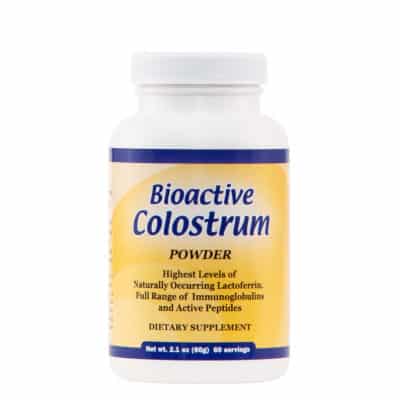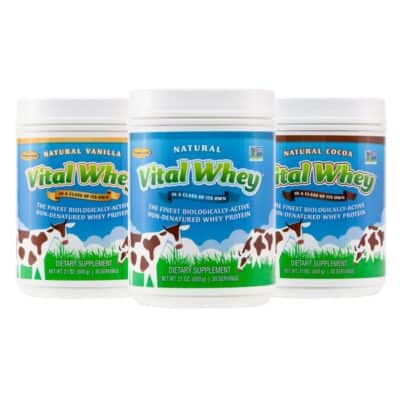We’ve all been a part of conversations where protein powder comes up as a suggested supplement for health, fitness, or body composition goals. Whey protein is among the most popular protein powders, a widely used variety derived from cow’s milk.
But what is whey protein and how effective is whey protein in building muscle? How long does it take to digest protein, anyway? Let’s examine the effectiveness of whey protein, including how fast you digest whey protein, and how to enhance its absorption. You’ll even learn some of the best ways to use whey protein as part of your everyday health routine, without changing much else.
What Is Whey Protein?
Whey protein is what you get when you curdle and strain dairy milk in order to isolate some of the more nutritious components. It’s rich in amino acids, which are used as building blocks for protein. Amino acids are also utilized to repair and rebuild muscle fibers that are broken down when you exercise.
Whey protein has the highest Biological Value (BV) of any other protein, meaning it is more efficiently absorbed and utilized for muscle-building purposes than any other protein.
Now, you may be wondering, how fast do you digest whey protein? To answer this question, let’s talk about how protein is digested and the factors involved in how quickly this process occurs in the body.
How is Protein Digested?
Is protein hard to digest? Not necessarily. Protein digestion starts as it enters your mouth with saliva and chewing being the first components to start the breakdown of that food. It moves through your stomach and intestines, where stomach acid, pancreatic enzymes, and other digestive enzymes continue to break the food down before its content is utilized, excreted, or stored for later use.
How Fast Do You Digest Whey Protein?
How long does it take to digest protein? There is around a 1.5-2 hour-long window during which protein is digested and absorbed. After that, the majority of it is unutilized or stored for later.
However, if you consume whey protein in the presence of milk or casein, it slows protein digestion, because these other proteins can cause the whey to clump. Consuming protein with fiber will also slow the process.
How long does it take for protein to digest? Amino acids are generally absorbed at the rate of 1.3-10 grams an hour. For whey protein, it’s about 8-10 grams per hour, compared to 5 grams per hour as a protein digestion time for casein.
Modest high-quality supplements are best. Aim for no more than 35% of your calories from protein, and somewhere between 0.8-1.1 grams per kg of your weight. Your protein needs, of course, depend on a variety of factors — such as your age, sex, activity level, and fitness or body composition goals.
One more note. You may be wondering how long it takes to digest a protein shake that’s already mixed and made ready to drink for you at the store. The pre-made ready-to-drink protein shakes contain additives like thickening agents, emulsifiers, and stabilizers, which improve texture and stability but make them harder to digest than real food — Compared to a shake you make at home with whey protein powder and liquid that will not include all the nutritionally unimportant added items.
Increasing Protein Absorption
Now that we’ve covered the digestion of protein, here is some vetted data and research that will help you maximize your ability to break down and absorb protein.
A possible way to increase protein absorption can be by stimulating the secretion of hydrochloric acid (HCl) — or stomach acid — around the time you consume it. This might include fermented foods like sauerkraut, kimchee, or ginger. HCl or zinc supplements may also help, but it’s best to speak with your healthcare provider first.
Probiotics help regulate the balance of microorganisms in your intestines. Some research suggests they help increase the activity of protease and peptidase which are enzymes needed to digest proteins.
Finally, one study found that protein consumption that was evenly distributed throughout the day increased muscle protein synthesis by about 25% over 24 hours. Another argument for quality over quantity — and spacing out your protein versus trying to get it all in one sitting for a quick result.
Other Benefits of Using Whey Protein
You have plenty of options to choose from when it comes to protein powder. But don’t get lost in the flashy claims and extreme amounts of protein per serving. Whey protein is among the most superior forms you will find.
In addition to its uses as a supplemental protein source, whey protein consumption may also benefit your health and goals in other ways. Let’s look at what else whey protein has to offer.
May Help Promote Feelings of Fullness
One of the reasons why protein can help achieve weight loss or other body composition goals is because it acts as an appetite suppressant. For example protein is digested more slowly than a piece of white bread, so you won’t find yourself hungry so soon after a protein-rich meal as you might without that protein rich food.
In combination with calorie reduction, whey protein can be a helpful addition to fat loss. Whey protein supplements combined with your regular workout routine can help satisfy your appetite and help you focus on your body composition goals instead. They can also help prevent overeating things that you might regret later.
May Support Healthy Blood Sugar Management
Whey protein may offer benefits for people who struggle to maintain steady blood sugar levels, such as individuals who have diabetes. Some studies have shown it to help increase insulin production in the body. Insulin is a hormone needed to bring blood sugar levels back within normal limits after eating.
In one 12-week study among overweight adults, researchers found that incorporating 54 grams per day of whey protein as part of the diet decreased fasting insulin by 11 percent and improved markers of insulin sensitivity by 10 percent.
Not only can whey protein help release insulin directly, according to the research, it also stimulates the release of hormone signals in the digestive tract that boost insulin function.
May Help Support Immune Health
Interestingly, whey protein may even help delay or prevent the onset of allergies that are common among children. One meta-analysis of 15 randomized controlled trials found that when whey protein was given to children who were at high risk for allergies — usually as a substitute for breast milk — partially hydrolyzed 100% whey formula could reduce the risk of contracting certain allergic diseases.
More research needs to be done, but this may indicate that whey protein encompasses some immune-modulating abilities that could potentially benefit adults, too.
How to Enjoy Whey Protein
Whey protein is a very popular supplement today. It’s been shown to help support body composition goals, promote satiety, and be easily digested for most people. Plus, it has a high gram-per-hour protein digestibility, making it a good choice when comparing protein powders on the market. When you take the approach of quality over quantity, your protein powder can work for you better.
While the most common way to use protein powder is to make protein shakes with it, you can also use it in baked goods like muffins and pancake batter. Whey protein powder can also be added to smoothies, cooked oatmeal, or homemade protein energy balls for a quick snack.
Vital Whey protein made by Well Wisdom is a 100% natural protein powder made with Proserum®, which is the best available. This minimally processed option is designed to maintain as many immune-modulating components naturally found in milk. It tastes good, is easy to use, and can be given as a supplement to athletes, adults, or even kids who need a protein boost.
Shop Vital Whey products here.
References
- https://www.precisionnutrition.com/rr-whey-too-much
- Bilsborough, S., & Mann, N. (2006). A review of issues of dietary protein intake in humans. International Journal of Sport Nutrition and Exercise Metabolism, 16(2), 129–152.
- Read “Dietary Reference Intakes for Energy, Carbohydrate, Fiber, Fat, Fatty Acids, Cholesterol, Protein, and Amino Acids” at NAP.edu. (n.d.). https://doi.org/10.17226/10490
- Renee, J. (2012, July 22). How to Improve Protein Powder Absorption. Healthy Living; azcentral.com. https://healthyliving.azcentral.com/improve-protein-powder-absorption-5029.html
- Wang, J., & Ji, H. (2019). Influence of Probiotics on Dietary Protein Digestion and Utilization in the Gastrointestinal Tract. Current Protein & Peptide Science, 20(2), 125–131.
- Mamerow, M. M., Mettler, J. A., English, K. L., Casperson, S. L., Arentson-Lantz, E., Sheffield-Moore, M., Layman, D. K., & Paddon-Jones, D. (2014). Dietary protein distribution positively influences 24-h muscle protein synthesis in healthy adults. The Journal of Nutrition, 144(6), 876–880.
- Frid, A. H., Nilsson, M., Holst, J. J., & Björck, I. M. E. (2005). Effect of whey on blood glucose and insulin responses to composite breakfast and lunch meals in type 2 diabetic subjects. The American Journal of Clinical Nutrition, 82(1), 69–75.
- Szajewska, H., & Horvath, A. (2010). Meta-analysis of the evidence for a partially hydrolyzed 100% whey formula for the prevention of allergic diseases. Current Medical Research and Opinion, 26(2), 423–437.
- Should You Take Whey Protein Powder After Surgery? - March 2, 2023
- How Much Protein is Too Much? - January 30, 2023
- Is Whey Protein Keto Friendly? - January 30, 2023






